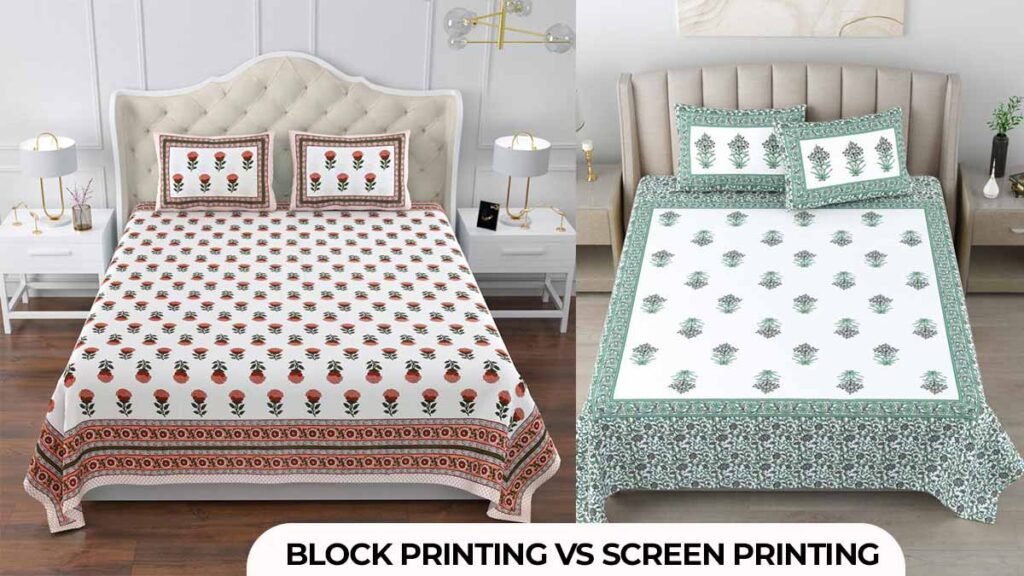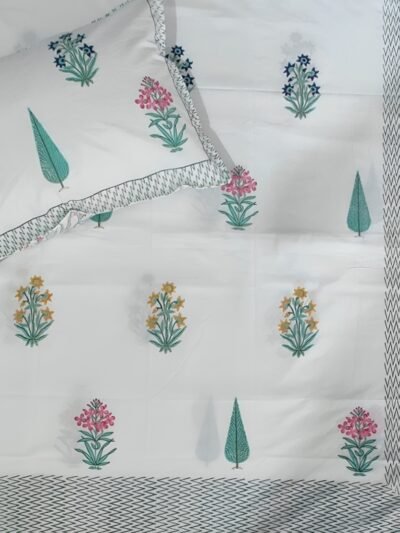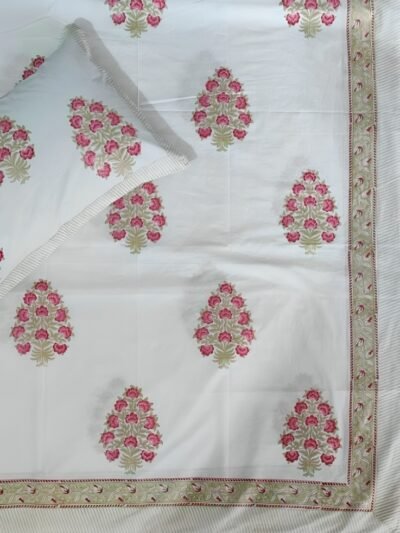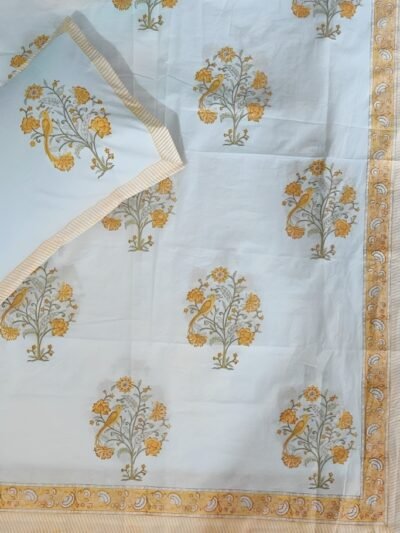Block printing and screen printing are popular techniques for printing designs onto various materials, including textiles like bed sheets. While both methods produce beautiful designs, they have distinct features and benefits that set them apart. As a consumer looking to purchase block-printed or screen-printed bed sheets, it can be challenging to understand the differences and make an informed decision.

What is block printing?
Block printing is a traditional technique that has been used for centuries to create intricate designs on textiles, paper, and other materials. In block printing, a design is carved into a block of wood or linoleum, and then ink is applied to the surface of the block. The block is then pressed onto the fabric, leaving an imprint on the design.
Block printing has a rich cultural history and is still widely used today in various parts of the world. For example, in India, block printing is known as “hand block printing” and is a significant part of the country’s textile industry. Block printing is also popular in countries like China, Japan, and Indonesia, where it has been used for centuries to create beautiful and intricate designs.
One of the key features of block printing is that it allows for intricate designs to be printed onto fabric with precision and detail. Because the design is carved into the block, the resulting print is consistent and uniform. Block printing also allows for a wide range of colors to be used, and natural dyes can be used for an eco-friendly and sustainable approach.
The benefits of using block printing for bed sheets include a unique and handmade aesthetic, durability, and resistance to fading. Block printed bed sheets are also easy to care for and can be machine washed and dried without losing their color or quality. For those interested in supporting local artisans and small businesses, block printed bed sheets offer an opportunity to do so while adding a touch of traditional charm to their home decor.
What is Screen Printing?
Screen printing, also known as silkscreen printing, is a popular method used to create designs on fabric, paper, and other materials. In screen printing, a stencil is used to create the design on a fine mesh screen, and ink is then pushed through the screen onto the fabric.
Screen printing offers a range of benefits, including the ability to produce large quantities of prints quickly and efficiently. Screen printing is also highly versatile and allows for a wide range of colors and designs. The resulting prints are vibrant and long-lasting, and screen printing offers a cost-effective option for producing high-quality designs.
One of the key features of screen printing is that it allows for precise and detailed designs to be printed onto fabric. This method is ideal for creating designs with clean lines and sharp edges, making it a popular choice for modern and graphic designs. Screen printing is also suitable for creating photographic designs, and it is often used to print logos and slogans onto t-shirts and other promotional materials.
The benefits of using screen printing for bed sheets include the ability to produce bold and striking designs with a high level of detail. Screen printed bed sheets are also highly durable and resistant to fading, making them a great option for long-term use. However, screen printing is not as eco-friendly as block printing, as it requires the use of synthetic inks and chemicals, which can be harmful to the environment if not disposed of properly.
Difference between Screen Printing and Block Printing
While both block printing and screen printing are popular methods for creating designs on fabric, there are some key differences between the two techniques.
- One of the main differences is the level of detail that can be achieved. Block printing is ideal for intricate and detailed designs, while screen printing is better suited for clean and bold designs with sharp edges.
- Another difference is the range of colors that can be used. Block printing allows for a wide range of colors and shades to be used, while screen printing is limited to a smaller range of colors.
- In terms of sustainability, block printing is the more eco-friendly option, as it can be done with natural dyes and does not require the use of harmful chemicals. Screen printing, on the other hand, requires the use of synthetic inks and chemicals, which can have negative impacts on the environment if not disposed of properly.
- Cost is another factor to consider when choosing between block printing and screen printing. Block printing can be more expensive due to the time and labor involved in carving the blocks and printing each design by hand. On the other hand, screen printing offers a cost-effective option for quickly producing large quantities of prints.
Ultimately, the choice between block printing and screen printing comes down to personal preference and the specific design and desired outcome. Both techniques offer unique and beautiful results, and each has its own set of advantages and disadvantages.
Screen Printing or Block Printing – Which one is better?
When deciding between block printing and screen printing, there are several factors to consider, including the level of detail in the design, the range of colors needed, sustainability, and cost.
Both block printing and screen printing are popular techniques for creating designs on fabric, paper, and other materials. While block printing is a traditional and eco-friendly method that offers intricate and unique designs, screen printing is a modern and versatile method that allows for bold and graphic designs in large quantities.
When deciding between block printing and screen printing, it’s important to consider factors such as the level of detail needed, the range of colors desired, sustainability, and cost. Ultimately, the choice between these two techniques will depend on your specific needs and preferences.



